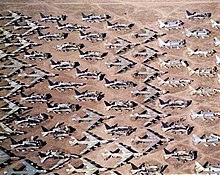An aircraft boneyard or aircraft graveyard is a storage area for aircraft which are retired from service. Most aircraft at boneyards are either kept for storage continuing to receive some maintenance or parts of the aircraft are removed for reuse or resale and the aircraft are scrapped. Boneyard facilities are generally located in deserts such as those in the southwestern United States, since the dry conditions reduce corrosion and the hard ground does not need to be paved.[1][2] In some cases, aircraft which were planned to be scrapped or were stored indefinitely without plans of ever returning to service were brought back into service, as the aviation market or the demands of military aviation changed or failed to develop as was anticipated.[3][4][5]

Some yards are privately owned and operated, others belong to the military including the 309th Aerospace Maintenance and Regeneration Group at Davis-Monthan Air Force Base in Tucson, Arizona.
After aircraft are put into boneyards, many are stripped of useful parts. Engines as well as most electronics, munitions, and wiring to be removed are recycled or kept in warehouses. The parts may serve as replacement parts for aircraft which are still flying or they may be used for reconditioning if and when the aircraft are called back into active duty. The parts along with the stripped aircraft may be sold to other countries.
Depending on the demands of the military or for commercial purposes, an aircraft or a whole squadron of the aircraft may be put back into active duty. The aircraft have to be reconditioned and tested so they will be airworthy. The reconditioning process includes putting in new avionics, electronics, safety measures, testing, and painting. Reconditioning of old aircraft is generally a cheaper way of getting more aircraft into service than buying new ones, and saves the United States billions of dollars annually.
Other nations' central aircraft storage facilities include the Russian Air Forces' Bases for Reserve Helicopters.
Military aircraft
The 309th Aerospace Maintenance and Regeneration Group in Tucson, the largest facility of its kind, is colloquially known as "The Boneyard".[1]
Commercial aircraft
Due to the impact of the COVID-19 pandemic on commercial air transport, demand for commercial aircraft storage increased dramatically in 2020. Furthermore, many aircraft which had initially been planned for short term storage were ultimately stored long term or even scrapped altogether, requiring maintenance work to prepare the planes for the different plans. As demand recovery behaved differently from expectations, temporary shortages as well as the requirement to prepare planes for long term storage after a few months of short term storage caused issues. Planes that have been stored for a few months can not be brought back to service on short notice.[6] The longer planes are stored, the more time it takes to get them fully airworthy and ready to fly again. Bringing a narrowbody aircraft back from long term storage takes roughly 40 worker hours while widebody aircraft require roughly 100 worker hours.[7]
Notable aircraft boneyards
| Location | Country | Notes |
|---|---|---|
| Alice Springs, Northern Territory[8] | Australia | First large-scale aircraft boneyard outside the United States.[9] |
| Saskatoon, Saskatchewan | Canada | Contains 23 old Fokker F-28 Fellowships of Canadian Regional Airlines and Air Canada Jazz.[8][10] Planes stored off service roads north of 09/27. |
| Mountainview, Ontario | Canada | Used primarily for storage of older RCAF Aircraft.[8] |
| Manas International, Chüy Region | Kyrgyzstan | Soviet era aircraft began to appear after 1991.[8] |
| Enschede Airport Twente[11] | Netherlands | |
| Teruel, Aragon[12] | Spain | |
| Cotswold Airport (formerly Kemble Airfield), Gloucestershire | United Kingdom | Air Salvage International, the leading European aircraft decommissioning company.[13] |
| RAF Shawbury, Shropshire[14] | United Kingdom | From end of World War II to 1972. |
| Davis-Monthan AFB, Arizona | United States | Nearly 4,400 aircraft on 2,600-acre, 309th Aerospace Maintenance and Regeneration Group.[1] |
| Kingman Field, Arizona | United States | Storage and repair for Delta, American and United.[15] |
| Pinal Airpark, Arizona[16] | United States | |
| Blytheville, Arkansas | United States | Storage and scrapping for retired aircraft including the MD-80 series aircraft. |
| San Bernardino, California | United States | Storage and scrapping for retired aircraft such as the MD-88. |
| Mojave Air and Space, California | United States | More than 100 planes. |
| Victorville, California[17] | United States | |
| Oscoda-Wurtsmith, Michigan | United States | Storage for Kalitta Air and other airlines. |
| Greenwood-Leflore Airport, Mississippi | United States | Storage, modification and scrapping for retired aircraft. |
| Tupelo, Mississippi | United States | Storage, modification and scrapping for retired aircraft. |
| Roswell, New Mexico | United States | Several large passenger and cargo jets.[18] |
| Laurinburg-Maxton, North Carolina | United States | Charlotte Aircraft Corporation strips former Northwest Airlines aircraft.[19] |
| Abilene Regional (Former), Texas[20] | United States | Many retired Saab 340s mostly from Envoy Air-American Eagle.[21] |
See also
- Aircraft Fleet Recycling Association
- Aircraft recycling
- PAMELA Project
- Ship graveyard
- Spacecraft cemetery
- Tarbes–Lourdes–Pyrénées Airport and Châteauroux-Centre "Marcel Dassault" Airport are also airports with aircraft boneyards
References
External links

- Map of aircraft boneyards around the world.